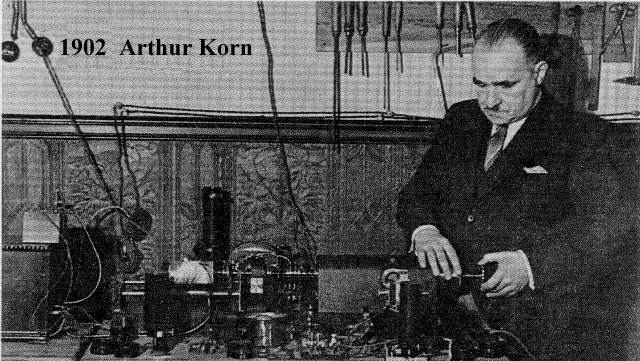|
Dr. Arthur Korn 1870 - 1945
Am 17. Oktober 1906 gelingt es dem Münchener Elektrophysiker Arthur Korn, ein Portrait von Kronprinz Wilhelm über eine Strecke von 1800 Kilometern telegrafisch zu übertragen. Mit dieser ersten "Bild-Telegrafie" wird die Grundlage gelegt für die spätere Entwicklung der Telekopie und des Fax.
 Real Audio file about the History of Fax ( received from DW in German ) Real Audio file about the History of Fax ( received from DW in German )
In 1902 the first practical photoelectric facsimile system is demonstrated by its German inventor Arthur Korn. It employed the light-sensitive
element selenium to convert the different tones of a scanned image into a varying electric current. This enabled 'halftone' illustrations to be transmitted for the first time.
Commercial use of Korn's system began in Germany five years later. By 1910, Paris, London and Berlin were all linked by facsimile transmission over the telephone network.
Source: http://www.cequel.co.uk/acclarke/shc.html
Korn was born on May 20, 1870 in Germany, and was still alive in 1943 (the publication date of Dunlap's book). He was appointed Professor of Physics at the University of Munich in 1903 [un]till retiring from that position in 1908. From 1914-36 was Professor of Electro-physics at the Berlin Institute of Technology. In 1904 [he] developed a system of seeing by wire. ( Dunlap also points out that Alexander Bain first produced a device to transmit pictures from one place to another over electric wires in 1842).
Korn had [a] (sheet of) photo[graphic] film put on a revolving glass drum inside a cylinder lighted only by a small aperture. The light was permitted to traverse both film and glass. The light [ray] regulated by the lights and shadows of the pictures was caught by a prism and thrown on a selenium cell connected with a battery. With this system in 1904 Korn sent telephone wire photos from Munich to Nuremberg - over 600 miles. He also sent the first wire photos from the continent to England in 1907. On May 6, 1922 he wired a picture from near Rome to Berlin and from which point it was radioed across the sea to the navy radio station in Maine in about forty minutes, it was a photo of Pope Pius the Eleventh.
He also developed a forty pound radio outfit to enable aircraft to pick up weather maps and military sketches in a minute and a half and aerial pictures in five minutes. This was called a phototelegraph. It was used by both sides during the Spanish Civil War and was taken up by military authorities in Russia, Poland, Italy and Germany. At 39 he and his wife and son emigrated to the USA [and took up a position] teaching in the Department of Electrical Engineering at Stevens Institute of Technology in Hoboken New Jersey.
Source: Loren Haroldson, Ellendale, MN, 56026, USA
|

